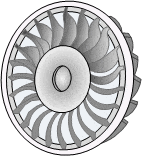
Water Turbine Design
Water Turbine Design for Small Scale Hydro Energy
![]() Hydro schemes use various types of water turbine design to produce a rotary turning action at a medium to high rotational speed. Also water turbines, or more specifically hydro turbines, can be used as part of a home hydro electricity system by installing an electrical generator.
Hydro schemes use various types of water turbine design to produce a rotary turning action at a medium to high rotational speed. Also water turbines, or more specifically hydro turbines, can be used as part of a home hydro electricity system by installing an electrical generator.
Unlike a water pump which is mechanically driven by an electric motor or wind turbine and uses suction to pump the water through it, a typical water turbine design uses nozzles and differential water pressure to produce a mechanical rotation and output.
In other words, a water turbine converts water pressure energy into mechanical energy. It is important at this point to understand the difference between a Water Turbine Design and a waterwheel design which we look at in the previous tutorial.
A waterwheel is a simple but large circular wooden or metallic wheel with buckets attached around its periphery that slowly turns as the flow of water pours over or underneath it producing lots of mechanical torque to drive auxiliary machinery. A water turbine on the other hand, is a much smaller, lightweight cast iron or steel machine in which the kinetic energy of the water is converted into mechanical energy through the use of correctly placed pressure nozzles.

The water turbine is the heart of any hydro power plant. It consists of a number of metal or plastic blades fitted to a central rotating shaft or plate. Water flowing through the casing of the enclosed turbine, strikes the blades of the turbine producing torque and making the shaft rotate due to the velocity and pressure of the water. As the water pushes against the turbine blades, its velocity and pressure reduces (energy is lost) as it rotates the turbine shaft.
However, as a typical “water turbine design” has lots more blades attached to this central shaft, this rotation causes the next blade behind it to come into contact with the entering water pressure causing the turbine to rotate some more and so on.
As the turbine continues to rotate, the water becomes trapped in between the turbines blades and is pushed along by the rotational movement of the turbine. At some point along the rotational angle of the turbine blades, the water encounters an opening in the casing, usually located at the center, which allows the water to exit and return back to the river or stream from where it originally came.
This waste water can pass through the body of a water turbine using different flow paths and based upon the actual path of water flow through the turbine, modern water turbine designs can be categorised as being either:
- Axial Flow Turbines – The water flow path through an axial flow water turbine design is parallel to the axis of rotation as it enters the turbines wheel from the side.
- Radial Flow Turbines – The water flows path through a radial flow water turbine design is perpendicular to the axis of rotation of the turbine as it enters the turbines wheel from above.
There are many different water turbine designs in use today, with each type having its own advantages and disadvantages depending upon their operational requirements. The selection of the correct type of water turbine design is very important for the success of any small or large scale hydro power system.
The optimum mechanical power output from the turbines rotating shaft relies on a specific combination of head height, water volume and water pressure entering the turbines blades, which can only be achieved by selecting the correct type of water turbine for a given installation. Then based upon the actual change in the waters pressure as it used by the turbines wheel, modern water turbine designs can be categorised as either:
- Reaction Turbine Design – in this type of water turbine design, the turbine blades are totally submersed in the flow of the water and are enclosed within a pressurised casing. A reaction turbine is powered mainly by the change in pressure, called a “pressure drop” across the casings body as this reduction in water pressure and velocity releases energy causing a reaction (hence the name) by moving the turbines blades. The flow of water through a reaction turbine may be reversed due to the angle of the internal blades, so a reaction turbine can also be used to pump water and vice versa.
- Impulse Turbine Design – in this type of water turbine design, the water flow hits the turbine blades from one or more jets of water known as nozzles. These nozzles convert the pressurised low velocity water into a high speed jet of water aimed directly at the turbines curved spoon or bucket shaped blades generating maximum force on the blades. The

